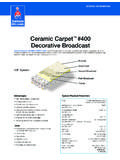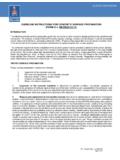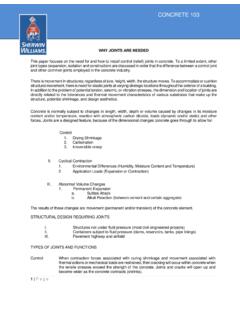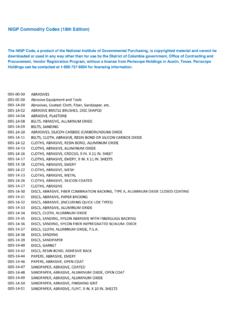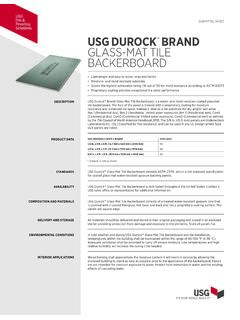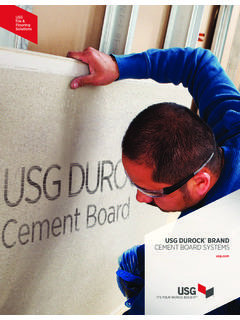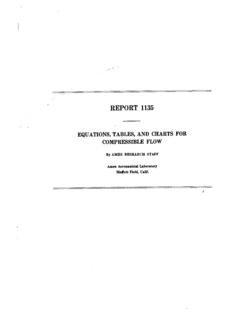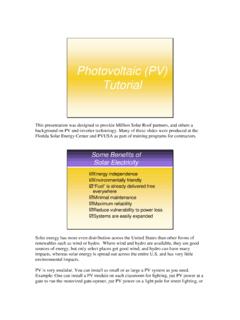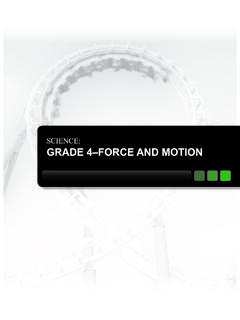Transcription of GUIDELINE INSTRUCTIONS FOR CONCRETE SURFACE …
1 SURFACE PREPARATION. GUIDELINE INSTRUCTIONS FOR CONCRETE SURFACE PREPARATION. (FORM G-1, REVISED 01/12). INTRODUCTION. The following CONCRETE SURFACE preparation guidelines , serves as an aide to owners, design professionals, specifiers and contractors. All surfaces to receive General Polymers sealers, coatings, mortars and resurfacers, must be structurally sound, clean and at minimum, saturated SURFACE dry (SSD). Proper SURFACE preparation is an extremely important factor in the immediate and long-term successful performance of applied polymer floor or wall systems. The contractor responsible for the installation of the polymer system shall be provided a substrate that is clean, durable, flat, pitched to specifications, SSD and free of SURFACE contaminants.
2 Providing the "proper substrate" is the responsibility of the owner, the owner's appointed representative and the CONCRETE contractor, unless specifically stated otherwise. Guide Specification for Cast in Place CONCRETE for Floor Slabs on Ground That Will Receive Semi-Permeable or Impermeable Floor Finishes , should be referred to for installation of fresh CONCRETE . Regardless of responsibility, the steps listed below must be accomplished prior to the placement of a bonded polymer system on CONCRETE . PROPER SURFACE PREPARATION. Proper SURFACE preparation includes the following: 1. Inspection of the CONCRETE substrate 2. Removal and replacement of non-durable CONCRETE 3.
3 Decontamination of the CONCRETE SURFACE 4. Creation of SURFACE profile 5. Repair of SURFACE irregularities 1. Inspection of the CONCRETE substrate to determine its general condition, soundness, presence of contaminants, presence of moisture vapor emissions and the best methods to use in preparation of the SURFACE to meet the requirements of the owner or the owner's appointed representative is critical. A proper evaluation will lead to the selection of the proper tools and equipment to accomplish the objective. 2. Removal and replacement of non-durable CONCRETE must be accomplished prior to installation of the polymer system. Localized weak or deteriorated CONCRETE must be removed to sound CONCRETE and replaced with cementitious or polymer CONCRETE repair mortars, or an engineered CONCRETE mix design utilizing GP4700 series polyacrylate polymer additive.
4 For application of these systems and compatibility with the selected polymer sealer, coating, lining or topping refer to the System Bulletins, Technical Data Sheets or the Technical Services Department. Occasionally, plain fresh CONCRETE is required and must be bonded to existing CONCRETE . When bonding fresh CONCRETE to existing, prepare the existing CONCRETE SURFACE by scabbling, scarifying, abrasive (sand) blasting, needle scaling, high pressure water jetting (5,000 to 45,000 psi), or steel shotblasting. Apply a low modulus epoxy as the bonding agent at a rate of 80 square feet per gallon for a WFT of 20 mils, and then place the fresh CONCRETE or mortar. Bonding to lightweight CONCRETE may require a second coat of epoxy if the first coat is readily absorbed into the CONCRETE SURFACE .
5 Always place the fresh CONCRETE within the open time of the epoxy, while the epoxy-bonding agent is still wet. Rough CONCRETE surfaces will require additional material depending on the SURFACE profile. Fresh CONCRETE should have a low water cement ratio (w/c). not to exceed When bonding fresh CONCRETE containing latex polymer admixtures, check compatibility of the latex modified CONCRETE mixture by either installing a test patch and performing a pull-off test, or by conducting a slant shear test in accordance with ASTM C 882, in an independent CONCRETE testing laboratory. GPI SURFACE Prep. Jan 2012/29. Page 1 of 6. 3. Decontamination of the CONCRETE SURFACE requires the removal of oils, grease, wax, fatty acids and other contaminants, and may be accomplished by the use of detergent scrubbing with a heavy duty cleaner/degreaser, low pressure water cleaning (less than 5,000 psi), steam cleaning, or chemical cleaning.
6 The success of these methods is dependent upon the depth of penetration of the contaminant; which is completely dependent upon the contaminant's viscosity, the CONCRETE 's permeability and the duration of exposure. Special care should be taken when preparing CONCRETE at an "in use" facility for repair, replacement or an initial floor topping. This is especially true for Food Processing facilities. Contaminants can be carried into exposed CONCRETE as most of these facilities use copious amounts of water. The contaminants can be animal fats/oils, blood, cleaning solutions, microbes, etc. They may not be completely removed during preparation (shot blasting). The CONCRETE may appear clean and well profiled.
7 A simple method to ensure you have sound CONCRETE is to test the pH. The chemistry of CONCRETE is alkaline in nature. Normal CONCRETE should be in the range of 11 to 13. Most of the contaminants mentioned are neutral to acidic in nature. After preparation test the floor in multiple locations using distilled water and the pH paper. If the pH is 10 or lower additional preparation will be required to ensure a good bond. In areas where the contaminants can not be removed, the contaminated CONCRETE must be removed and replaced as in 2., above. CAUTION: Decontamination methods that introduce large amounts of water may contribute to moisture related problems as referenced in APPENDIX A.
8 4. Creation of SURFACE profile can be accomplished by a number of methods each utilizing a selection of tools, equipment and materials to accomplish the intended purpose, (See METHODS OF SURFACE PREPARATION below). Selection is dependent upon the type of SURFACE to be prepared and the type of system to be installed. In addition, floors, walls, ceilings, trenches, tanks and sumps each have their own particular requirements. The type and thickness of the selected polymer system also plays an important role in the selection process. Regardless of the method selected or tools employed, we must provide a SURFACE that will accept the application of polymer-based products and allow the mechanical bond of the polymer securely to the CONCRETE .
9 The type of service the structure will be subjected to, will also help to define the degree of profile required. The SURFACE profile is the measure of the average distance from the peaks of the SURFACE to the valleys as seen through a cross sectional view of the SURFACE of the CONCRETE . This dimension is defined pictorially and through physical samples in the ICRI Technical GUIDELINE No 03732, and is expressed as a CONCRETE SURFACE Profile number (CSP 1-9). For General Polymers coating and sealing applications from 4 to 15 mils in thickness, the SURFACE profile shall be CSP 1, 2, or 3, typically accomplished through decontamination of the CONCRETE SURFACE as defined in 3.
10 Above, followed by acid etching, grinding, or light shotblast.. For General Polymers EPO-FLEX and other coating applications from 15 to 40 mils in thickness, the SURFACE profile shall be CSP 3, 4, or 5, typically accomplished through decontamination of the CONCRETE SURFACE as defined in 3. above, followed by light shotblast, light scarification or medium shotblast. For General Polymers CERAMIC CARPET , TRAFFICOTE , AquArmor S, AquArmor MCS, FasTop . MVT and other topping applications from 40 mils to 1/8", the SURFACE profile shall be CSP 4, 5, or 6. These are typically accomplished through decontamination of the CONCRETE as defined in #3 above, followed by light scarification, medium shotblast or medium scarification.

